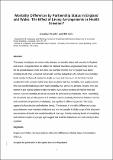Files in this item
Mortality differences by partnership status in England and Wales : the effect of living arrangements or health selection?
Item metadata
| dc.contributor.author | Franke, Sebastian | |
| dc.contributor.author | Kulu, Hill | |
| dc.date.accessioned | 2018-05-22T23:32:54Z | |
| dc.date.available | 2018-05-22T23:32:54Z | |
| dc.date.issued | 2018 | |
| dc.identifier | 249386467 | |
| dc.identifier | 065be1d9-8650-4a39-adf4-29b4f60f3428 | |
| dc.identifier | 85019881950 | |
| dc.identifier | 000423142800004 | |
| dc.identifier.citation | Franke , S & Kulu , H 2018 , ' Mortality differences by partnership status in England and Wales : the effect of living arrangements or health selection? ' , European Journal of Population , vol. 34 , no. 1 , pp. 87-118 . https://doi.org/10.1007/s10680-017-9423-7 | en |
| dc.identifier.issn | 0168-6577 | |
| dc.identifier.other | ORCID: /0000-0001-8808-0719/work/75996978 | |
| dc.identifier.uri | https://hdl.handle.net/10023/13476 | |
| dc.description | Sebastian Franke’s research was supported by the Economic and Social Research Council [ES/J500094/1] through the North West Doctoral Training Centre Social Statistics pathway (Ph.D. project: “Health, Mortality and Partnership Status: Protection or Selection”). The permission of the Office for National Statistics to use the Longitudinal Study is gratefully acknowledged, as is the help provided by staff of the Centre for Longitudinal Study Information and User Support (CeLSIUS). CeLSIUS is supported by the ESRC Census of Population Programme (Award Ref: ES/K000365/1). | en |
| dc.description.abstract | This paper investigates the relationship between partnership status and mortality in England and Wales. Using data from the Office for National Statistics Longitudinal Study (ONS LS) for the period between 2001 and 2011, we examine whether married people have lower mortality levels than unmarried individuals; whether individuals who cohabit have mortality levels similar to those of married or single persons; and how much the fact that married couples live with someone rather than alone explains their low mortality. Our analysis shows first that married individuals have lower mortality than unmarried persons. Second, men and women in pre-marital unions exhibit mortality levels similar to those of married men and women, whereas mortality levels are elevated for post-marital cohabitants. Third, controlling for household size and the presence of children reduces mortality differences between married and unmarried non-partnered individuals, but significant differences persist. The study supports both protection and selection theory. The increase in mortality differences by age group between never-married cohabitants and married couples is likely a sign of the long-term accumulation of health and wealth benefits of marriage. Similar mortality levels of cohabiting and married couples at younger ages suggest that healthier individuals are more likely to find a partner. | |
| dc.format.extent | 32 | |
| dc.format.extent | 1118198 | |
| dc.language.iso | eng | |
| dc.relation.ispartof | European Journal of Population | en |
| dc.subject | England and Wales | en |
| dc.subject | Survival analysis | en |
| dc.subject | Mortality differences | en |
| dc.subject | Marital status | en |
| dc.subject | Cohabitation | en |
| dc.subject | ONS LS | en |
| dc.subject | HN Social history and conditions. Social problems. Social reform | en |
| dc.subject | 3rd-DAS | en |
| dc.subject.lcc | HN | en |
| dc.title | Mortality differences by partnership status in England and Wales : the effect of living arrangements or health selection? | en |
| dc.type | Journal article | en |
| dc.contributor.sponsor | Economic & Social Research Council | en |
| dc.contributor.sponsor | Economic & Social Research Council | en |
| dc.contributor.institution | University of St Andrews. Geography & Sustainable Development | en |
| dc.identifier.doi | 10.1007/s10680-017-9423-7 | |
| dc.description.status | Peer reviewed | en |
| dc.date.embargoedUntil | 2018-05-22 | |
| dc.identifier.grantnumber | ES/K000446/1 | en |
| dc.identifier.grantnumber | ES/K000365/1 | en |
This item appears in the following Collection(s)
Items in the St Andrews Research Repository are protected by copyright, with all rights reserved, unless otherwise indicated.

